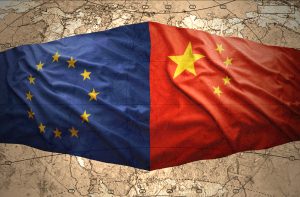The president of the European Commission, Ursula von der Leyen, did not mention China when she launched the Global Gateway (GG), essentially an umbrella strategy to synchronize already existing EU and member states global infrastructure investment programs. But because of the way the self-styled “geopolitical Commission” presented it, observers and officials were quick to frame the GG as a European challenge to China’s BRI — itself launched in 2013 to fund infrastructure development projects mostly in developing and middle-income countries in Asia and around the globe.
Global Gateway aims to mobilize 300 billion euros (around $337 billion) over a five-year period to invest in digital and transport infrastructure, energy generation and transmission, and health projects. In addition to smaller EU grants, Global Gateway taps into national and EU resources from financial institutions and development banks, in the hope that institutional spending will unlock significant private capital, too.
Critics will correctly highlight that the Global Gateway is mostly repackaging existing programs and also that the investment sum remains a fraction of what China is mobilizing.
But the real limitation is in the framing.
European investment, especially now in health infrastructure, is meaningful and impactful. EU investments have made tangible differences on the ground in much of the developing world as well as in middle-income countries. This strengthens ties with Asia, Africa, and, importantly, the Western Balkan region, and it raises environmental, democracy, and human rights standards.
Overseas infrastructure investments are always partly geopolitical, seeking to increase the investing country’s own influence while trying to minimize space for others. The EU is no different and naturally seeks to advance its interests and competitiveness.
But Chinese critics allege that the EU’s objective was not to support lower-income countries but to confront Beijing. And indeed, there is some truth to it. Von der Leyen advertised Global Gateway as “in line with the EU’s democratic values” and specifically mentioned China, with which some countries allegedly had bad experiences.
The question is, why should Global Gateway and other non-Chinese investment projects, such as the G-7’s Build Back Better World (B3W), seek to counter Chinese investments?
Speaking for Asia at least, the answer starts with a slew of unintentional or deliberate misunderstandings in Europe and America, overestimating the BRI’s impact.
First, without the fanfare of pseudo-geopolitical competition, not China but Japan is the largest infrastructure investor, silently and seamlessly implementing affordable good quality projects, especially in Southeast Asia.
Second, the BRI is not a threat to Asia but mostly beneficial and in high demand. There have been problems relating to debt and implementation. But many middle- and low-income countries are not anxiously waiting for value-driven Western agendas. They seek investment and business and trade opportunities, and decent relations with Beijing. Generally, the BRI is viewed favorably.
While Europe meets high standards and enjoys great credibility and reputation, the assumption that China does not is flawed. In Western narratives, Chinese investments are often portrayed as primarily geopolitically motivated, not in the region’s but only in China’s strategic interest. But painting the BRI as predatory and part of some masterplan to subjugate the region is fiction more than reality.
There is some truth to allegations pertaining to low quality, questions over imported Chinese workers, and insufficient financial and ecological feasibility studies. But the BRI is now approaching a decade of experience, and China, though relatively new to global investment projects, has learned important lessons from the first phase of BRI (2013-2017).
China has gained much experience in building physical infrastructure at home, where China can claim some of the best transport infrastructure in the world, and abroad, where projects have now decreased in quantity and increased in quality. Beijing is also increasingly showing greater empathy for the local economy and sensitivities, and the BRI is moving into new areas of sustainable growth and health where there is great demand.
There is plenty of room for complementary multi-source investment. McKinsey sees an infrastructure investment gap several times the total BRI volume, and the Asian Development Bank estimates Asia’s needs to be $26 trillion through 2030. In other words, even if China were to double the BRI’s investment volume, would still be room for 10 Global Gateways.
While the BRI mobilizes state-owned commercial and policy banks, it is unclear whether the EU will indeed be able to tap into private capital. Infrastructure projects are costly and yield uncertain returns.
Global Gateway is an excellent and meaningful strategy. But instead of trying to outcompete China and lamenting low standards, the EU could make a difference by setting examples, gradually raising the bar for all.
Unlike others, China has repeatedly emphasized its willingness to cooperate. Just as Global Gateway is intended to synchronize with B3W, Global Gateway should not be Europe’s challenge to the BRI but a natural complement. Europe should find ways to coordinate and synergize various national and supra-national projects and share best practices and information. It can also prioritize areas less penetrated by the BRI, especially India and Eastern Europe.
Old myths die hard. But the myth that the BRI is a predatory and unsolicited instrument is a particularly resilient one. Not everything needs to be seen through the lens of binary competition, and not everything Beijing does is ipso facto bad simply because Beijing does it. The increasingly tense nature of geopolitical great power competition is having negative spill-over effects, which may cloud judgment and complicates the enormous task of plugging the world’s infrastructure gap. The EU can do better than that.

































